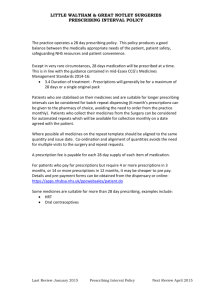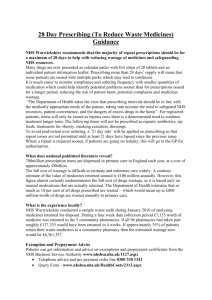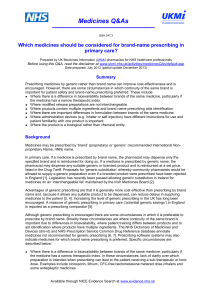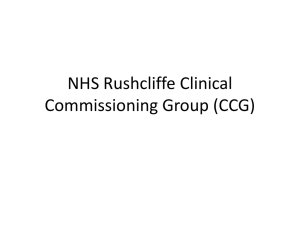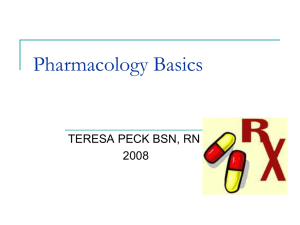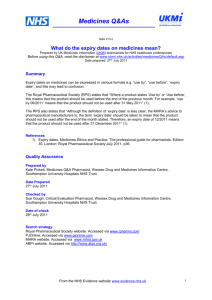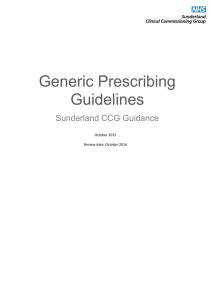Q&A 247.1a - NHS Evidence Search
advertisement
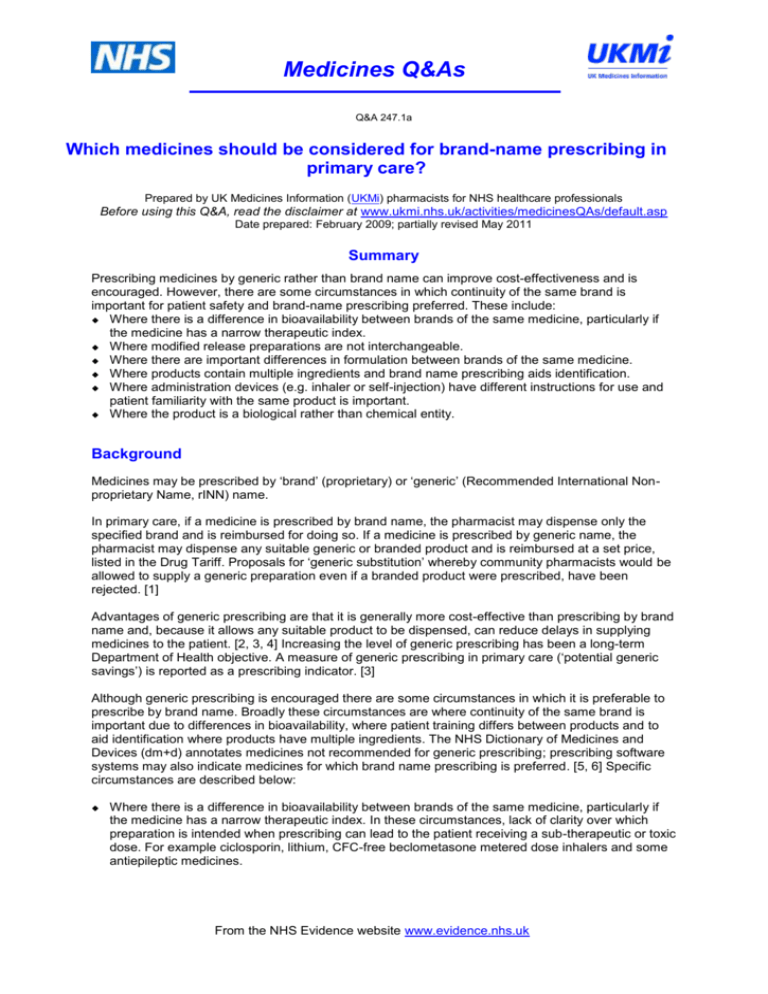
Medicines Q&As Q&A 247.1a Which medicines should be considered for brand-name prescribing in primary care? Prepared by UK Medicines Information (UKMi) pharmacists for NHS healthcare professionals Before using this Q&A, read the disclaimer at www.ukmi.nhs.uk/activities/medicinesQAs/default.asp Date prepared: February 2009; partially revised May 2011 Summary Prescribing medicines by generic rather than brand name can improve cost-effectiveness and is encouraged. However, there are some circumstances in which continuity of the same brand is important for patient safety and brand-name prescribing preferred. These include: Where there is a difference in bioavailability between brands of the same medicine, particularly if the medicine has a narrow therapeutic index. Where modified release preparations are not interchangeable. Where there are important differences in formulation between brands of the same medicine. Where products contain multiple ingredients and brand name prescribing aids identification. Where administration devices (e.g. inhaler or self-injection) have different instructions for use and patient familiarity with the same product is important. Where the product is a biological rather than chemical entity. Background Medicines may be prescribed by ‘brand’ (proprietary) or ‘generic’ (Recommended International Nonproprietary Name, rINN) name. In primary care, if a medicine is prescribed by brand name, the pharmacist may dispense only the specified brand and is reimbursed for doing so. If a medicine is prescribed by generic name, the pharmacist may dispense any suitable generic or branded product and is reimbursed at a set price, listed in the Drug Tariff. Proposals for ‘generic substitution’ whereby community pharmacists would be allowed to supply a generic preparation even if a branded product were prescribed, have been rejected. [1] Advantages of generic prescribing are that it is generally more cost-effective than prescribing by brand name and, because it allows any suitable product to be dispensed, can reduce delays in supplying medicines to the patient. [2, 3, 4] Increasing the level of generic prescribing has been a long-term Department of Health objective. A measure of generic prescribing in primary care (‘potential generic savings’) is reported as a prescribing indicator. [3] Although generic prescribing is encouraged there are some circumstances in which it is preferable to prescribe by brand name. Broadly these circumstances are where continuity of the same brand is important due to differences in bioavailability, where patient training differs between products and to aid identification where products have multiple ingredients. The NHS Dictionary of Medicines and Devices (dm+d) annotates medicines not recommended for generic prescribing; prescribing software systems may also indicate medicines for which brand name prescribing is preferred. [5, 6] Specific circumstances are described below: Where there is a difference in bioavailability between brands of the same medicine, particularly if the medicine has a narrow therapeutic index. In these circumstances, lack of clarity over which preparation is intended when prescribing can lead to the patient receiving a sub-therapeutic or toxic dose. For example ciclosporin, lithium, CFC-free beclometasone metered dose inhalers and some antiepileptic medicines. From the NHS Evidence website www.evidence.nhs.uk Where modified release preparations are not interchangeable, particularly if the medicine has a narrow therapeutic index. This avoids confusion between formulations with different release characteristics. Examples include aminophylline, diltiazem and morphine. Where there are important differences in formulation between brands of the same medicine. For example, fentanyl patches which are available as matrix formulations (e.g. Durogesic DTrans, Matrifen) and reservoir formulations (e.g. Tilofyl). Reservoir patches must not be cut because damage to the rate-limiting membrane can lead to a rapid release of fentanyl resulting in overdose. If the prescriber intends the patch to be cut (although this is unlicensed and not recommended by the MHRA) then the prescription must specify a brand of matrix formulation patch. Where products contain multiple ingredients and brand name prescribing aids identification. This is useful when prescribing products with multiple ingredients (e.g. pancreatin supplements, skin and scalp preparations) and to differentiate between similar products where patient familiarity with a brand is important (e.g. hormone replacement therapy and oral contraceptives). Where administration devices have different instructions for use and patient familiarity with the same product is important. For example salbutamol dry powder inhalers and adrenaline pre-filled syringes. Where the product is a biological rather than chemical entity. Such agents are licensed as ‘biosimilar’ medicines. Examples include erythropoietin and somatropin (growth hormone) preparations. Answer The following table lists medicines that might be considered for brand-name prescribing. This table has been compiled using a number of sources. Specific references for individual medicines are included where appropriate. BNF Drug or drug class Reason for considering brand-name prescribing Specific references Chapter 1 1.1.2 Antacids preparations containing simeticone To aid identification. Products contain multiple ingredients. - Compound alginates and proprietary indigestion preparations To aid identification. Products contain multiple ingredients. - 1.5.1 Mesalazine oral preparations The delivery characteristics of oral mesalazine preparations may vary and should not be considered interchangeable. BNF 1.6.4 Macrogols (polyethylene glycols) To aid identification. Products contain multiple ingredients. - 1.9.4 Pancreatin supplements To aid identification. Products contain multiple ingredients. - Chapter 2 2.6.2 Diltiazem modified release preparations MR preparations have different release characteristics and are not interchangeable. BNF 2.6.2 Nifedipine modified release preparations MR preparations have different release characteristics and are not interchangeable. BNF From the NHS Evidence website www.evidence.nhs.uk BNF Drug or drug class Reason for considering brand-name prescribing Specific references Chapter 3 3.1.1 Formoterol dry powder inhalers Patient familiarity with one brand is important; instructions for use vary between preparations. dm+d 3.1.1 Salbutamol dry powder inhalers Patient familiarity with one brand is important; instructions for use vary between preparations. dm+d 3.1.3 Theophylline modified release preparations MR preparations have different release characteristics and are not interchangeable. Theophylline has a narrow therapeutic index. BNF 3.1.3 Aminophylline modified release preparations MR preparations have different release characteristics and are not interchangeable. Aminophyline has a narrow therapeutic index. BNF 3.2 Beclometasone dipropionate CFCfree pressurised metered dose inhalers Qvar and Clenil Modulite are not interchangeable. Qvar has extra-fine particles and is approximately twice as potent as Clenil Modulite and CFCcontaining beclometasone inhalers. The MHRA has advised that CFC-free beclometasone inhalers should be prescribed by brand name. This applies also to combination products. BNF, MHRA [7] 3.2 Beclometasone dry powder inhalers Patient familiarity with one brand is important; instructions for use vary between preparations. 3.2 Beclometasone and formoterol CFC-free metered dose inhalers See beclometasone CFC-free metered dose inhalers, above. 3.4.3 Adrenaline pre-filled syringes Patient familiarity with one brand is important; instructions for use vary between preparations. dm+d BNF dm+d BNF, MHRA [7] Chapter 4 4.2.3 Lithium preparations Preparations vary widely in bioavailability. Changing the preparation requires the same precautions as initiation of treatment. Lithium has a narrow therapeutic index. 4.4 Methylphenidate modified release preparations MR preparations contain different proportions of immediate-release and modified-release methylphenidate. 4.7.2 Morphine oral modified release preparations MR preparations have different release characteristics; Patient familiarity with one brand is important. From the NHS Evidence website www.evidence.nhs.uk - PCF3 [8] BNF Drug or drug class Reason for considering brand-name prescribing Specific references 4.7.2 Fentanyl patches Patches are available as matrix and reservoir formulations; Patient familiarity with one brand is important. Reservoir patches (e.g. Tilofyl) must not be cut because damage to the rate-limiting membrane can lead to a rapid release of fentanyl resulting in overdose. If the prescriber intends the patch to be cut (although this is unlicensed and not recommended by the MHRA) then the prescription must specify a brand of matrix formulation patch (e.g. Durogesic DTrans, Matrifen). PCF3 [8], MHRA [9] 4.8.1 Antiepileptic medicines Loss of seizure control has been reported in patients after switching brands of antiepileptic medicines. Continuity of the same brand, or the same generic preparation is recommended for patients with seizure disorders. (For individual antiepileptic agents, see below.) NICE [10], Epilepsy Action [11] 4.8.1 Carbamazepine Different preparations may vary in bioavailability. Carbamazepine has a narrow therapeutic index. (See also ‘Antiepileptic medicines’ above.) BNF 4.8.1 Lamotrigine Generic and branded products are bioequivalent. See also ‘Antiepileptic medicines’ above. MHRA [12] 4.8.1 Phenytoin On the basis of single dose tests there are no clinically relevant differences in bioavailability between available phenytoin sodium tablets and capsules but there may be a pharmacokinetic basis for maintaining the same brand of phenytoin in some patients. Phenytoin has a narrow therapeutic index. (See also ‘Antiepileptic medicines’ above.) 4.8.1 Topiramate Generic and branded products are bioequivalent. See also ‘Antiepileptic medicines’ above. 4.9.1 Apomorphine pre-filled syringe Patient familiarity with one brand is important; instructions for use vary between preparations. dm+d 4.9.3 Botulinum toxin type A Preparations are not interchangeable due to differences in potency. BNF Patient familiarity with the same brand is important; training is required in the use of specific devices for self-injection. dm+d BNF MHRA [13] Chapter 6 6.1.1 Insulin From the NHS Evidence website www.evidence.nhs.uk BNF Drug or drug class Reason for considering brand-name prescribing Specific references 6.4.1 Hormone replacement therapy oral preparations Different brands of the same formulation are available. Patient familiarity with one brand is important. - 6.4.1 Estradiol transdermal patches Different brands of the same formulation are available. Patient familiarity with one brand is important. dm+d 6.5.1 Somatropin injection cartridges Patient familiarity with the same brand is important and training is required in the use of specific devices for self-injection. Some somatropin preparations are licensed as ‘biosimilar’ medicines. dm+d, BNF Chapter 7 7.3.1 Combined oral contraceptive Different brands of the same formulation are available. Patient familiarity with one brand is important. - 7.3.2 Progestogen only oral contraceptive Different brands of the same formulation are available. Patient familiarity with one brand is important. - 7.4.5 Alprostadil injection Patient familiarity with one brand is important; instructions for use vary between preparations. dm+d Chapter 8 8.2.1 Mycophenolate Generic mycophenolate is considered bioequivalent to CellCept; but it may be prudent not to change formulation except on the advice of a transplant specialist. Mycophenolate mofetil and mycophenolic acid preparations are not interchangeable. BNF, PJ [14], Renal News [15] 8.2.2 Ciclosporin Preparations are not interchangeable and should be prescribed by brand-name to avoid inadvertent switching. It is important not to change formulation except on the advice of a transplant specialist. Ciclosporin has a narrow therapeutic index. BNF, Renal News [15], MHRA [16] 8.2.2 Tacrolimus Preparations are not interchangeable; care should be taken to ensure the correct preparation is prescribed and dispensed. It is important not to change formulation except on the advice of a transplant specialist. Tacrolimus has a narrow therapeutic index. BNF, MHRA [17] 8.2.4 Interferon pre-filled disposable injection devices Patient familiarity with one brand is important; instructions for use vary between preparations. Peginterferon pre-filled disposable injection devices From the NHS Evidence website www.evidence.nhs.uk dm+d BNF Drug or drug class Reason for considering brand-name prescribing Specific references Chapter 9 9.1.3 Erythropoietin Patient familiarity with the same brand is important and training is required in the use of specific devices for self-injection. Some epoetin preparations are licensed as ‘biosimilar’ medicines. BNF, UKMi [18] 9.1.6 Pegfilgrastim Patient familiarity with the same brand is important and training is required in the use of specific devices for self-injection. Generic filgrastim has been approved as a ‘biosimilar’ medicine. dm+d, BNF, UKMi [18] Filgrastim 9.2.1 Oral rehydration salts To aid identification. Products contain multiple ingredients. - 9.5.1 Calcium salts To aid identification. Products contain multiple ingredients. - To aid identification. Products contain multiple ingredients. - To aid identification. Products contain multiple ingredients. Also, potency of topical corticosteroids preparations is a result of the formulation as well as the corticosteroid. - Chapter 12 12.3.5 Saliva replacement products Chapter 13 13.113.10 Preparations for skin and scalp conditions containing multiple ingredients Limitations This list of medicines may not be comprehensive and is the opinion of the author. References 1. Department of Health. Press release: No plans to implement generic substitution of medicines. 14 October 2010. Accessed online at http://www.dh.gov.uk/en/MediaCentre/Pressreleases/DH_120502 on 5/5/11. 2. Joint Formulary Committee. British National Formulary. 61st ed. London: British Medical Association and Royal Pharmaceutical Society of Great Britain; 2008. Accessed online via www.bnf.org on 5/5/2011. 3. Prescribing Support Unit. The Prescribing Toolkit 2009-10. August 2009. Accessed online at http://www.ic.nhs.uk/webfiles/Services/PSU/2009%20Toolkit_Guide.pdf on 5/5/2011. 4. National Prescribing Centre. Generic prescribing in primary care. MeReC Bulletin 2011; 21(3). Accessed via www.npc.nhs.uk/merec/other_non_clinical/merec_bulletin_vol21_no3.php on 8/5/11. 5. NHS Business Services Authority. NHS Dictionary of Medicines and Devices Editorial Policy. Release 2 version 3.0. 23 August 2010. Accessed at http://195.97.218.30/docs/EBPolicy_NHSdmd_August_2010.doc on 5/5/11. 6. NHS Prescription Services, NHS Business Services Authority. List of items not recommended for prescribing as a VMP. Personal communication 18/2/2011. From the NHS Evidence website www.evidence.nhs.uk 7. Medicines and Healthcare products Regulatory Agency. Letter from the Chief Executive. Beclometasone dipropionate pressurised metered dose inhaler important information. 8 th August 2006. Accessed via www.mhra.gov.uk/home/idcplg?IdcService=GET_FILE&dDocName=CON2024433&RevisionSelec tionMethod=LatestReleased on 8/5/2011. 8. Palliative Care Formulary 3. Accessed via www.palliativedrugs.com on 8/5/2011. 9. Medicines and Healthcare products Regulatory Agency. Fentanyl patches: serious and fatal overdose from dosing errors, accidental exposure, and inappropriate use. Drug Safety Update 2008; 2(2): 2-3. Accessed via www.mhra.gov.uk/Publications/Safetyguidance/DrugSafetyUpdate/CON025631 on 8/5/2011. 10. National Institute for Clinical Excellence. Clinical guideline 20: The epilepsies – the diagnosis and management of the epilepsies in adults and children in primary and secondary care. October 2004. Accessed via www.nice.org.uk/Guidance/CG20 on 8/5/2011. 11. Epilepsy Action. Why do my drugs look different? 23rd March 2011. Accessed via www.epilepsy.org.uk/info/drugs_change.html on 8/5/2011. 12. Department of Health. Treatment for epilepsy: generic lamotrigine. 2 nd March 2005. Accessed via www.dh.gov.uk/en/Healthcare/Medicinespharmacyandindustry/Prescriptions/DH_4104966 on 8/5/2011. 13. MHRA Public Assessment Report. Topiramate 15mg and 25mg hard capsules. Arrow Generics Ltd. Accessed at www.mhra.gov.uk/home/groups/par/documents/websiteresources/con057253.pdf on 8/5/2011. 14. Tynan S and Jerram P. Generic or branded mycophenolate – what strategy should the NHS adopt? Pharm J 2010; 285 (7630): 659-660. 15. Black H. Implications of generic drugs in renal disease. Renal News 2011; 2: 3-4. 16. Medicines and Healthcare products Regulatory Agency. Information sent to healthcare professionals October 2010: Capimune (ciclosporin). Accessed via www.mhra.gov.uk/Safetyinformation/Safetywarningsalertsandrecalls/Safetywarningsandmessages formedicines/Monthlylistsofinformationforhealthcareprofessionalsonthesafetyofmedicines/CON099 712 on 8/5/2011. 17. Medicines and Healthcare products Regulatory Agency. Tacrolimus (Advagraf and Prograf): risk of serious medication errors. Drug Safety Update 2009; 2(6): 4-5. Accessed via www.mhra.gov.uk/Publications/Safetyguidance/DrugSafetyUpdate/CON035989 on 8/5/2011. 18. Gough S. UKMi Medicines Q&A: What are biosimilar medicinal products? 23rd December 2009. Accessed via www.nelm.nhs.uk/en/NeLM-Area/Evidence/Medicines-Q--A/What-are-biosimilarmedicinal-products/?query=biosimilar&rank=100 on 12/5/11. Quality Assurance Prepared by Karoline Brennan, North West Medicines Information Centre Date Prepared February 2009 (partial revision May 2011) Checked by Simone Henderson, North West Medicines Information Centre Christine Proudlove, North West Medicines Information Centre Date of check February 2009 (partial revision checked May 2011) From the NHS Evidence website www.evidence.nhs.uk
